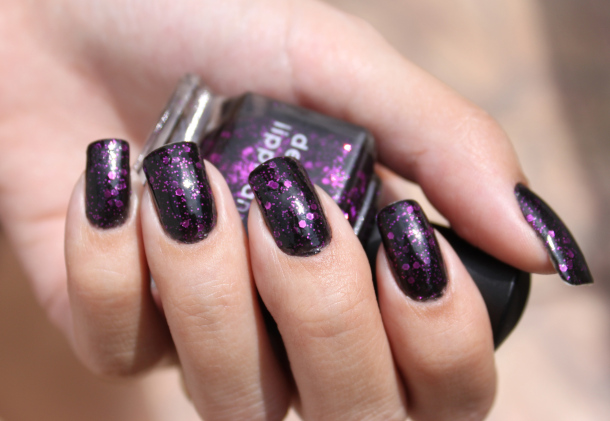New FDA Rules for Cosmetics
Air Date: Week of December 15, 2023

Nail polish, among other cosmetics, often contains harmful chemicals. (Photo: Lelê Breveglieri, Wikimedia Commons, CC BY 2.0)
A new law updates cosmetics regulations at the Food and Drug Administration for the first time in 85 years. But gaping loopholes remain for ingredient disclosure and safety testing, amid the continued presence of carcinogens, hormone disruptors and other harmful chemicals in cosmetics. Hosts Aynsley O’Neill and Steve Curwood explain the update and its impact with help from Inside Climate News Reporter Victoria St. Martin.
Transcript
O’NEILL: From PRX and the Jennifer and Ted Stanley Studios at the University of Massachusetts, Boston this is Living on Earth. I’m Aynsley O’Neill.
CURWOOD: And I’m Steve Curwood. Later in the broadcast we’ll mark the historic moments at COP28 in Dubai as the world’s nations agree to transition away from fossil fuels. But first, Aynsley you’ve got a cosmetic safety update, right?
O’NEILL: Yeah, Steve, as you know what’s in the cosmetics that millions of Americans use on our skin, hair, and nails every single day is often a big question mark. What we do know is that some of the chemicals found in things like shampoos, deodorants, and lipsticks have been linked to serious health problems, but there’s a huge regulatory gap. Back in 2019 the House Energy and Commerce Subcommittee on Health chaired by Democratic Congresswoman Anna Eshoo of California, held a hearing on this gap.
ESHOO: The only thing standing between Americans and a dangerous cosmetic product is an 80-year-old federal law, the 30 employees at the FDAs office of cosmetics and colors and strongly worded letters from the FDA. To put it bluntly, we don’t know what’s in our cosmetics, and what we don’t know could hurt us.

Congresswoman Anna Eshoo chaired a hearing in 2019 that led to the Modernization of Cosmetics Regulation Act. (Photo: Brian Washburn, Wikimedia Commons, CC BY 2.0)
O’NEILL: So, A new law, the Modernization of Cosmetics Regulation Act, goes into effect at the end of this month, and that’ll give the Food and Drug Administration more power to regulate the industry. I spoke with Inside Climate News reporter Victoria St. Martin, who has been reporting on this and walked me through some of the health risks from products containing such toxins as formaldehyde.
ST. MARTIN: It’s linked to cancers - reproductive cancers like uterine cancer, breast cancer, endometrial cancer. Formaldehyde is not only used in chemical hair straighteners and hair smoothers, but it’s also used as a preservative in personal care and cosmetics.
O’NEILL: There are also parabens, which disrupt hormones and harm the reproductive system and even heavy metals including mercury.
ST. MARTIN: It’s in a lot of skin lighteners and it can damage the kidneys and the nervous system.
CURWOOD: Yikes. And we’ve talked with researchers who study the health impacts of endocrine disrupting phthalates in cosmetics. Those are linked to obesity, diabetes, and pre-term birth, among other health problems.
O’NEILL: Right. And Steve, Victoria says the US is really behind some other industrialized countries when it comes to protecting consumers from the harmful chemicals in these products.
MARTIN: In the European Union they ban 2,000 and counting chemicals from cosmetics. In the United States at this moment, 11 chemicals are restricted or banned.
O’NEILL: That’s a disparity reflected in how we regulate chemicals here in the US in general. Instead of a precautionary principle, we wait to see harmful effects from chemicals already on the market, and then we consider banning them. Unfortunately, although these new rules are a good start, they don’t change that basic system. They focus more on disclosure.
CURWOOD: Yeah, you know, we’ve reported on how the word “fragrance” is often used by the cosmetics industry to hide some of these chemicals from ingredient lists by claiming they are proprietary. Things like phthalates. So how might these new rules help rein in that?

Exposure to harmful chemicals in beauty products, including formaldehyde, increases the risk of developing cancer, including breast cancer. (Photo: Caroline Gutman, Courtesy of Inside Climate News)
O’NEILL: Well, although companies will now need to report to the FDA what chemicals are in that “fragrance,” they will only need to list those chemicals on the label consumers see if the ingredients can cause allergic reactions. So, that doesn’t change all that much in terms of what information is readily available to the public about what’s actually in a product. But the new law does give FDA more authority to recall products when consumers report adverse effects. Another new requirement is that companies will need to conduct safety testing.
But Steve, Victoria St. Martin of ICN points out that there’s a huge catch.
ST. MARTIN: So companies will have to do this safety testing but the FDA won’t be able to make sure it’s happening. So it’s like, I will say that I did my homework, but my mom can’t look at my homework [LAUGHS] and make sure that I actually did it.
CURWOOD: Wow. So how can people be sure these products are safe?
O’NEILL: Well, with significant regulatory gaps remaining, it’s really still up to us consumers to do our homework on whether the products we use are safe. There are resources like the “Skin Deep” cosmetics database from the Environmental Working Group, which lets you type in a product name and learn more about its ingredients if the company has made that information available. And Victoria explained that pressure from the public for safer cosmetics really seems to be leading the charge to make regulatory changes.
ST. MARTIN: I don’t think there’ll be another 85 years with little regulation. I just don’t think that’s ever going to happen anymore. Those days are gone. The more that we push to have safer and cleaner products, not only will our lawmakers answer, but also industry will as well, because if we’re not buying products that we are concerned about, then they won’t make them anymore.
O’NEILL: So maybe someday, the ingredients in the shampoo, moisturizer and deodorant we buy won’t be a mystery.
CURWOOD: That’ll be good to know.
Links
Read the full text of the Modernization of Cosmetics Regulation Act
Read Victoria St. Martin’s original story on Inside Climate News
Explore options for safe and eco-friendly personal care products
Living on Earth wants to hear from you!
Living on Earth
62 Calef Highway, Suite 212
Lee, NH 03861
Telephone: 617-287-4121
E-mail: comments@loe.org
Newsletter [Click here]
Donate to Living on Earth!
Living on Earth is an independent media program and relies entirely on contributions from listeners and institutions supporting public service. Please donate now to preserve an independent environmental voice.
NewsletterLiving on Earth offers a weekly delivery of the show's rundown to your mailbox. Sign up for our newsletter today!
 Sailors For The Sea: Be the change you want to sea.
Sailors For The Sea: Be the change you want to sea.
 The Grantham Foundation for the Protection of the Environment: Committed to protecting and improving the health of the global environment.
The Grantham Foundation for the Protection of the Environment: Committed to protecting and improving the health of the global environment.
 Contribute to Living on Earth and receive, as our gift to you, an archival print of one of Mark Seth Lender's extraordinary wildlife photographs. Follow the link to see Mark's current collection of photographs.
Contribute to Living on Earth and receive, as our gift to you, an archival print of one of Mark Seth Lender's extraordinary wildlife photographs. Follow the link to see Mark's current collection of photographs.
 Buy a signed copy of Mark Seth Lender's book Smeagull the Seagull & support Living on Earth
Buy a signed copy of Mark Seth Lender's book Smeagull the Seagull & support Living on Earth

